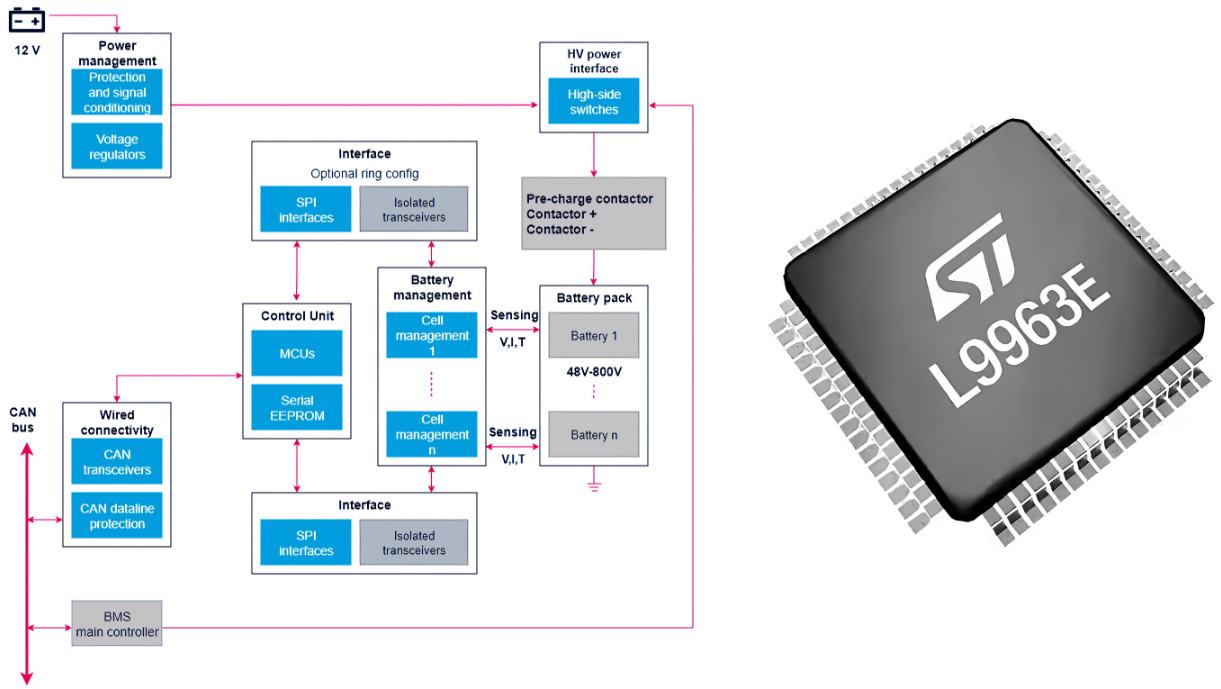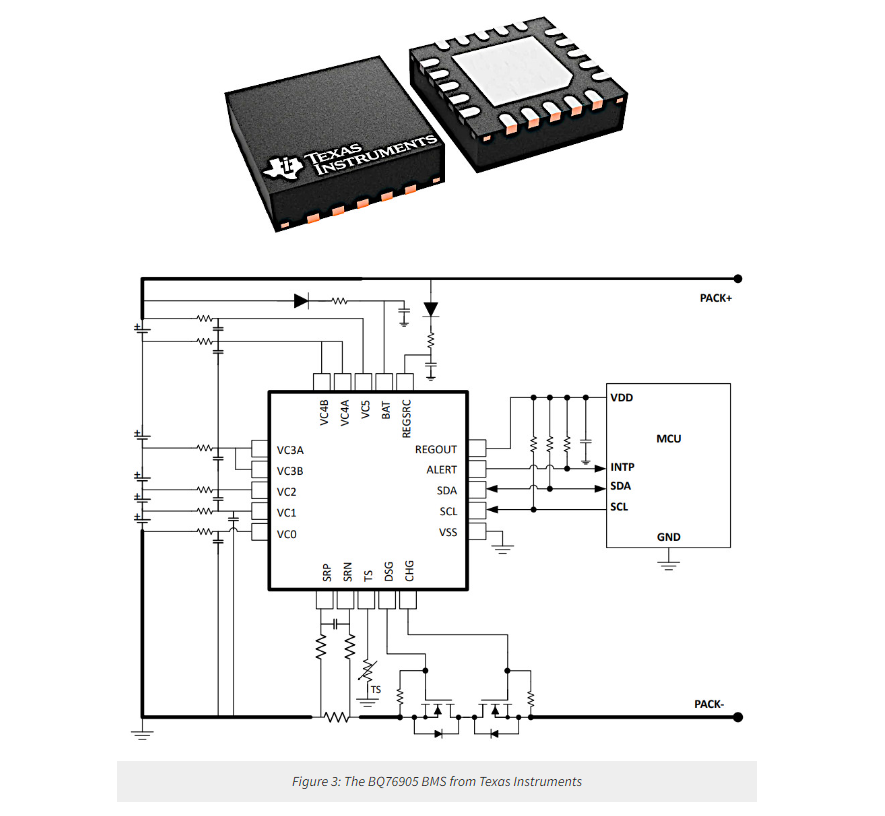
At the present, modern batteries are much more powerful and can provide autonomous and fast charging for long periods of time in complete safety for cars, trains and even planes. A dedicated circuit known as a battery management system (BMS) can extend the life of the battery and improve the safety of the battery in terms of use and charging. The type of battery most affected by BMS are rechargeable batteries, particularly lithium-ion batteries, which are currently found in most applications from smartphones to electric vehicles. These intelligent systems play a key role in monitoring, controlling and optimizing battery performance and life, while ensuring user and load safety.
Introduction
The battery management system (BMS) is the basis for the long-term safe and efficient operation of batteries. It has many functions, some of which are very complex (see the block diagram in Figure 1). The first function is battery monitoring, which collects a large amount of information about the main parameters of the battery in real time. Some of them are related to the output current, charging current, current voltage, current temperature, and charging state. This information is used to assess the health of the battery and check for any abnormalities.
A very important function is to control the charge and discharge current to prevent energy overload or deep discharge, which affects the life of the battery itself. The temperature is also carefully monitored to avoid overheating and possible explosions or fires. The most complex models involve sending current independently to the individual units to ensure optimal balance. The battery management system also implements various safety measures to protect the battery from damage, breakdowns and failures. It intervenes in the event of abnormal distribution or charging, immediately interrupting charging or discharging in dangerous situations.
Some models are equipped with special circuitry and can even transmit various information collected to other systems via wired or wireless connections. This possibility is very useful if the battery is located in a place that is difficult for the operator to access. The simplest systems monitor voltage and current and check for any overloads, while more advanced systems implement cell balancing, communication with other systems, and advanced diagnostics.

Improving the battery management
Electronic and automated battery management for electric vehicles is one of the most demanding challenges today, and one of the most critical factors is the selection of integrated circuits to perform many functions. A good system must first understand the battery pack architecture of an electric vehicle. Typically, they consist of a certain number of cells in series, parallel, or mixed to multiply the voltage or current and gain more energy.
Each battery is usually equipped with an electronic module that is constantly monitored, and the system collects all information to ensure the safe operation of the battery. The BMS performs a number of tasks, such as precise thermal management, accurate voltage and current measurements, excellent balance of individual battery charge levels, and a range of system safety procedures. In fact, the main functions of the management system are as follows:
● Battery protection: it ensures normal operation and prevents any unforeseen operations in its operating area
● Battery monitoring: it constantly checks the state of charge and health of the battery during charging and discharging
● Battery optimization: it guarantees a good balance of the cells, improving the life and capacity of the battery, thus optimizing the autonomy of electric vehicles.
The valuable role of BMS, which performs battery undervoltage or overvoltage control, is analyzed in detail. Lithium batteries will be damaged when charged and discharged outside a certain voltage range, usually between 10.5V and 14.8V. At this point, the BMS will automatically block the battery. In addition, it also realizes automatic protection against high continuous and pulsed maximum discharge current. It automatically protects the system from short circuits that can easily cause explosions and fires, and provides an effective and continuous check of the operating temperature, because lithium batteries cannot be charged below 0°C and above 55°C, and cannot work properly below -20°C and above 60°C.
BMS also plays a fundamental role in controlling the maximum charge current, as LiFePO4 batteries can be charged faster than lead-acid batteries, but the limits must always be adhered to. Finally, the battery management system achieves battery balance, a topic that will be explored in depth in the next paragraph. An example of an effective BMS is the battery management solution produced by ST. Based on the L9963E integrated circuit (see Figure 2), it provides the highest precision measurement of up to 14 units in series in single or bidirectional configurations and enables very complex cell monitoring and diagnostic functions.

Another example of a BMS is the BQ76905 from Texas Instruments (see Figure 3), which integrates battery monitoring from two to five cells in series; A protection circuit includes voltage, temperature, current, and internal diagnostics. It implements a battery balance function that must be controlled to limit the current and avoid exceeding the recommended operating temperature of the device. This is achieved by correctly calculating the cell input resistance and limiting the number of cells that can be balanced at a time.

Battery balancing
Compared with traditional batteries, lithium batteries have many advantages and the best results, but in the production process, the same and uniform model based on nominal capacity, internal resistance and self-discharge cannot be guaranteed. These small differences, over time, can throw the battery out of balance, reduce efficiency, and accelerate aging. Internal batteries are connected in series, and their charging and discharging use the same amount of energy. Without a proper balancing system, the differences between the batteries will grow larger and larger, actually damaging the battery. So if you charge the battery unevenly, the weaker battery will reach full capacity before the more powerful one.The general problem is due precisely to the presence of the weakest cells.
The balance function allows you to extend the life cycle of your batteries as they undergo thorough and independent checks in each part. This feature maximizes the total capacity of the battery and prevents local undercharging or overcharging. With this technology, BMS ensures that all the batteries that make up the battery have the same charging state. Depending on the technique used, there is passive balancing operation, in which a battery with excess charge dissipates power (and heat) using a power resistor to balance the charge states of all the batteries. In this method, the most charged batteries are drained of their energy by connecting them to a power load, such as a passive regulator. Therefore, a common BMS system applies a resistance to the battery with the most charge and waits for the battery with the least charge to reach the same energy level. This method can achieve low efficiency, balance the process is very long, even tens of hours, and does not extend the battery life, although it is very economical.
Active balancing, on the other hand, is more complex and expensive, but good results can be obtained because the current is independently redistributed among individual cells during the charge-discharge cycle; In addition, its implementation is very fast, sometimes even minutes. This method transfers energy from a more charged battery to a less charged one, or reduces the charging current to a level low enough that a fully charged battery is not damaged, and a less charged battery can continue to charge. This increases autonomy and does not result in a particular increase in system temperature.
However, with passive or active battery balancing, each cell in the battery pack can be monitored to maintain good charging status. As a result, balance extends the average battery life and provides an additional level of protection against damage to the battery due to deep discharge or overcharging. Analog Devices provides an example of a circuit for active cell balancing, whose LT8584 is shown in Figure 4. It is a monolithic fly back converter with a 2.5a discharge current and is used with the LTC680x series cell monitors.

Conclusion
With enough BMS, battery life increases significantly. Prevent battery damage due to improper use, such as overcharging or deep discharge. The BMS is the true brain of the battery, and if designed with cutting-edge electronics, it can perform many additional functions, controlling and monitoring the behavior of the battery in real time.
About US
Heisener Electronic is a famous international One Stop Purchasing Service Provider of Electronic Components. Based on the concept of Customer-orientation and Innovation, a good process control system, professional management team, advanced inventory management technology, we can provide one-stop electronic component supporting services that Heisener is the preferred partner for all the enterprises and research institutions.
